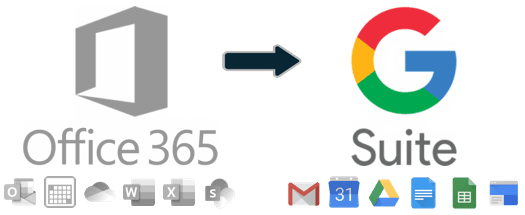Cloud Technology
Google Workspace
Microsoft 365Migrating from Microsoft 365 to Google Workspace: Tips to Remember
Migrating from one platform to another, particularly one that forms the bedrock of an organization, can be extremely stressful and sub-optimal if not carefully charted. Here are some pointers to lay the groundwork for one such transformational change: migrating from Microsoft 365 to Google Workspace.
By
Dave Wallen
4 minute read
Migrating from one platform to another, particularly one that forms the bedrock of an organization, can be extremely stressful and sub-optimal if not carefully charted. Here are some pointers to lay the groundwork for one such transformational change: migrating from Microsoft 365 to Google Workspace. ## 1) Know Why
## 1) Know Why
Google Workspace, with its high speed and mobile-first solutions, is fast gaining converts and is used by 5 million companies worldwide. To make the most of your Google Workspace adoption, however, it is essential to take a step back and understand the reasons why Google Workspace is the best fit for your organization. Drawing up the business case for the migration to Google Workspace will not only help you get stakeholder buy-in, but will also help you maximize Google Workspace’s capabilities that match your business’ requirements. Some business cases for Google Workspace include:
- Mobile-first platform for enhanced mobile usage and interoperability: Google Workspace is leaner than Microsoft 365, and is built for enhanced mobility — it runs on a browser, requires no installation and is device agnostic. There is no compromise in the user experience when accessing it from either a desktop or mobile device. Additionally, it supports easy switching between personal and work accounts. All together making it a great fit if the majority of employees require extensive mobile usage.
- Faster speed for remote access: The other advantage of Google Workspace’s leanness is its high speed even with slow connectivity and device processing power. Once again, a boon for remote workers.
- Better collaboration mechanisms for distributed teams: Google Workspace shines with its ease of use and features built specifically with distributed teams in mind. For instance, it facilitates easy document collaboration with real-time viewing of comments and edits by colleagues. With Gmail you can review documents, spreadsheets and presentations directly from your email, without opening separate apps.
- Low cost, hands-free adoption: At the core of Google’s values is ease-of-use. The kind that is intuitive to the point of being simplistic, but without compromising on performance. Which is precisely why a search engine with only a text-box and a search button became the most widely-used one. Google Workspace stays true to that ethos by being easy enough for employees to use from the get-go with minimal IT Team hand-holding and training. This is beneficial for organizations of all sizes, from SMBs, educational institutions and non-profits with limited IT Admin resources to large global enterprises with support teams that are stretched thin.
2) Lay the Groundwork
Due diligence prior to migration will ensure that your organization adopts Google Workspace holistically and optimally. Check that the triad of People-Processes-Tools is well in place.
- People: Get stakeholder buy-in on the scope and timeline to guarantee a smooth migration. Cultivate Google Workspace evangelists across levels, who are pros in applying Google Workspace’s apps and features to their department’s business workflows. Provide regular communication to all employees about the migration timeline, downtime (if any), information about Google Workspace’s features (Google Workspace offers a helpful learning center), migration support contacts, etc.
- Process: Decide on the extent of your Google Workspace migration. Will it be only email and documents? Will it include all users? Will all data be migrated? Plan the type of migration — hybrid or phased? Chalk out the timeline across departments.
- Tools: Complex migrations can benefit greatly from Google Workspace migration tools or partners. Understand the limitations of the tools. For example, Google’s Data Migration Services may not seamlessly migrate OneDrive files. Moving them manually may be your only option. Additionally, some applications in Microsoft 365 may not have a 1-1 substitute in Google Workspace, such as Planner or OneNote. You will have to find a suitable replacement for application functionality not offered by Google.
3) Secure your Migration
Check that your Google Workspace migration meets compliance and regulation requirements. This, as in the case of GDPR will require you to protect from data loss during the move. A reliable backup and recovery tool will protect your data in Microsoft 365, enable you to move it effortlessly, and then continue to provide similar protection in Google Workspace. Spanning has top-rated backup and recovery solutions for both Microsoft 365 and Google Workspace, offering you a dependable safety net for your entire migration process. In addition, Spanning offers licensing options tailored for migration between Google Workspace and Microsoft 365. Contact us now to know how.
Looking to do the reverse? Read our Migrating from Google Workspace to Microsoft 365 blog to learn more.
Get Started with Spanning Today